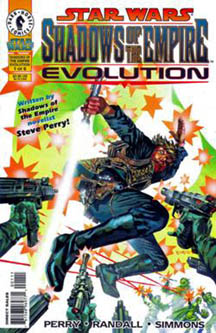As I noted in my last flashback post, “Shadows of the Empire” was created in a boardroom to be the major “Star Wars” project of 1996. So if any of the creative people — including book author Steve Perry or Ryder Windham, who also had a creative role — had an idea, it had to be approved by the higher-ups.
Today, it’s clear that “Shadows of the Empire” didn’t have as big an impact on the overall universe as its creators thought it would. After all, characters like Guri, Dash Rendar and Jix rarely pop in further adventures. However, there were a couple of attempts to keep the series going, and the writers no doubt were happy that they didn’t have to answer to a committee: 1997’s “Shadow Stalker,” Windham’s one-shot Jix comic that was originally serialized in Star Wars Galaxy Magazine, and 1998’s “Shadows of the Empire: Evolution,” Perry’s five-issue comic series about Guri.
These two stories are polar opposites in style: Windham utilizes small panels and a lot of dialog in telling the grim backstory of Jix. We learn that Jix saved Darth Vader’s life during the Empire’s invasion of his home planet. He theorized that if Vader died, the Empire would come down in full force. So Jix saved Vader’s life in exchange for the Dark Lord’s promise that the Empire leave his planet alone. But Vader — known for getting the better of these types of deals, as we saw with Lando — also worked it out so Jix has to do his bidding in order to keep the deal in place. My only disappointment is that this story isn’t actually shown, it’s only spoken of in dialog. I mean, how many people can say they saved Darth Vader’s life? The Emperor and Jix?

“Evolution,” on the other hand, fully embraces the “show, don’t tell” maxim. This five-issue series — continuing the story of Guri, whom Perry made sure to keep alive at the end of his novel (she paraglided off the exploding palace) — can be read as quickly as the one-shot “Shadow Stalker.” Many panels and some entire pages don’t have dialog at all. And the beautiful human replica droid Guri, as drawn by Ron Randall, doesn’t show emotion on her face. And yet, she comes across as an introspective, pensive character, and there’s a melancholy drama to her pursuit of a mind-wipe that will allow her to be a good “person,” rather than the assassin she was programmed by Xizor to be.
The heroes — Han, Luke, Leia, Lando, Chewie and the droids — are awkwardly worked into this story. But Perry writes good banter, and you can tell he relishes showing Han’s reactions to discovering the details of the events in “Shadows of the Empire.” This story takes place after “Return of the Jedi,” but — in contrast to many post-“Jedi” stories — it aims to retain the adventurous, action-packed spirit of the films. Lando’s not an entrepreneur yet, Leia’s not a politician yet, Han and Leia are still a bit hostile in their bickering, and Luke’s still trying to master Jedi skills. In one great panel, Han distracts a floating, meditating Luke with “Who let that Rancor in here!,” the Jedi equivalent of waking someone up by banging on pots and pans.

The final page offers a twist as the newly good Guri meets Dash Rendar in a cantina. This will be an inexplicable surprise to readers of the book, who know Dash died in the battle over Coruscant. However, players of the “Shadows” video game know he actually survived by jumping to lightspeed just before the Outrider apparently blew up. Why the “Shadows” brain trust kept Dash’s survival out of the comic and novel, I don’t know. In fact, “Evolution” tries to get even more mileage out of the “Who’s actually alive after all?” angle by teasing that Xizor is still alive. He’s not, but Perry does introduce some of his relatives.
If the 1996 “Shadows of the Empire” marked the creation of the sandbox, then these two comics are the only examples of writers playing in it. But they also pretty much marked the end. Although Dash popped up in the novel “Shadow Games,” set before the original movie trilogy, the story of what happened between him and Guri has yet to be told. “Shadow Stalker” and “Evolution” aren’t essential “Star Wars” material, but for “Shadows” fans, they’re worth checking out.

